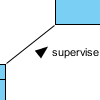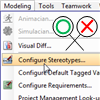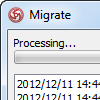How to Upgrade VP-UML (With Single Seat License) to New Version [Obsolete]
| This article is out-dated. Please refer to How to upgrade Visual Paradigm (with Single Seat License) to New Version for details about how to update your single seat licensed Visual Paradigm to latest version. |
| Visual Paradigm for UML (VP-UML) was discontinued since the product amalgamation in version 11.1. More details can be found at http://www.visual-paradigm.com/aboutus/newsreleases/vp-product-amalgamation-2014.jsp |
From time to time Visual Paradigm release new version to Visual Paradigm for UML (VP-UML) which cover bunch of new features and enhancements. Thanks to the maintenance contract system, you can upgrade to new version without extra cost as long as your license is covered by maintenance contract. This article will teach you how to upgrade your single seat license of VP-UML to new version. Read more
Why the modification on a newly created element will reflect to an existing model element?
Visual Paradigm’s modeling tools are running in share model basis. This is meaning that a single model element can appear on different diagrams, or even on the same diagram multiple times (we call it the “views”). Changing the model element on one of the view will automatically reflected to other views. But sometimes you can may found that when you make changes on a new model element, changes also applied to other elements in your project, which is not what you looking for. There are 2 possibilities for this problem to be happen: Read more
How to Draw a Directed Association
 In UML (Unified Modeling Language), an association can be used to represent that two classifiers which are related with each other. On any binary association, you may optionally put a solid triangular arrowhead near the name of the association to define the way the association should be read. In this article, we will see how to show the triangular arrowhead on an association in Visual Paradigm.
In UML (Unified Modeling Language), an association can be used to represent that two classifiers which are related with each other. On any binary association, you may optionally put a solid triangular arrowhead near the name of the association to define the way the association should be read. In this article, we will see how to show the triangular arrowhead on an association in Visual Paradigm.
How to Commit or Update Multiple Teamwork Projects at a Time
 Commit sends your local changes to server, while update grabs from server the latest changes made by your teammates. Frequent committing and updating help ensure that people in your team are all working on the latest and common project data. If you have a large number of projects in your workspace, the mass commit and mass update function are particularly helpful. They can save you time by committing or updating all projects in workspace in one go, rather than to do it project by project. In this article, you will learn how to commit and update multiple projects at one time. Note that the techniques to cover apply to any of the supported concurrent versioning systems: Visual Paradigm Teamwork Server, SVN, CVS, Perforce, ClearCase.
Commit sends your local changes to server, while update grabs from server the latest changes made by your teammates. Frequent committing and updating help ensure that people in your team are all working on the latest and common project data. If you have a large number of projects in your workspace, the mass commit and mass update function are particularly helpful. They can save you time by committing or updating all projects in workspace in one go, rather than to do it project by project. In this article, you will learn how to commit and update multiple projects at one time. Note that the techniques to cover apply to any of the supported concurrent versioning systems: Visual Paradigm Teamwork Server, SVN, CVS, Perforce, ClearCase.
Read more
How to Configure Client Permissions via VP Server
 When your team is composed of people with different roles and authorities, you may want to have control over their actions in the modeling tool, to prevent them from making undesired changes. For example, while it is reasonable for a software architect to build class models, it is not reasonable for him to restructure any model developed, through the refactor feature. With VP Server, administrator is allowed configure the access rights of features for members or member groups. For example, by turning off the “manage referenced project” permissions for a member, he/she won’t be able to add and remove referenced project. In this article, you will see how to configure client permission when creating and editing a member.
When your team is composed of people with different roles and authorities, you may want to have control over their actions in the modeling tool, to prevent them from making undesired changes. For example, while it is reasonable for a software architect to build class models, it is not reasonable for him to restructure any model developed, through the refactor feature. With VP Server, administrator is allowed configure the access rights of features for members or member groups. For example, by turning off the “manage referenced project” permissions for a member, he/she won’t be able to add and remove referenced project. In this article, you will see how to configure client permission when creating and editing a member.
Read more
Create Diagram Image Shape with API
Your diagrams are not necessary to be modeled just with the standard notations. With the Diagram Image Shapes, you can enrich your diagram with customized image files. The Diagram Image Shapes can be created via the prattle of the diagram, as well as using Open API. This article will show you how to create Diagram Image Shapes from an image file deployed in your plugin using Open API. Read more
Mass Project Migration from Old to New version
 When Visual Paradigm release a new new version, it comes with many new and enhanced features. In order for a project file created in an old version to work smoothly in new version, it has to undergo a conversion process, which involve the checking and patching of project data. The conversion process is a one-off procedure done when you first open the project in new version. It may take a while to complete. So you can imagine if you are working as a team and your team have many, many projects, conversion can be a fairly daunting task.
When Visual Paradigm release a new new version, it comes with many new and enhanced features. In order for a project file created in an old version to work smoothly in new version, it has to undergo a conversion process, which involve the checking and patching of project data. The conversion process is a one-off procedure done when you first open the project in new version. It may take a while to complete. So you can imagine if you are working as a team and your team have many, many projects, conversion can be a fairly daunting task.
For this reason, Visual Paradigm introduced the mass project migration feature. It helps you convert a group of projects from old version to new version at the same time, and eventually have them committed to the server automatically. With this, you can assign one team member to execute the mass project migration. And when the migration is complete, ask the rest of the team re-checkout the projects from server. Since the projects have been converted, team members can directly open the project without having to wait for any project conversion, which saves a great deal of time.
Notice that the technique described in this article applies to any users who use Visual Paradigm’s client products (VP-UML/Agilian/Lorigizn) with any kind of supported concurrent versioning system (VP Server, SVN, CVS, Perforce, ClearCase).
How to Hide out the Name of Association in Class Diagram
 Association is one of the key elements for constructing class model. It is not just a line relating 2 classes but also carrying lots of information describing their relationship. Giving a meaningful name to the association would help to make it easier to understand. Visual Paradigm allows you to show and hide the name of the association in a flexible way. Read more
Association is one of the key elements for constructing class model. It is not just a line relating 2 classes but also carrying lots of information describing their relationship. Giving a meaningful name to the association would help to make it easier to understand. Visual Paradigm allows you to show and hide the name of the association in a flexible way. Read more
How to Evaluate Different Editions of VP Products [Obsolete]
During evaluation you may want to try out different editions of the software to see which one fit for your needs. In the old version you can launch the Product Edition Manager to switch the edition of the installed software. Starting from version 10 SP1 release you can do this directly within the application. To switch the edition: Read more
How to Share Report Composer Templates Effectively with VP Teamwork Server [Obsolete]
| This article is out-dated. For user on Visual Paradigm 12.1 or above please refer to How to Share Doc. Composer Templates with your Teammates for details about how to share your templates. |
 Report Composer allows you to develop reports tailored to your company/industry requirements and standards. You can decide the project data to show in a report as well as to control the flow of content. You can decide the document component (e.g. table, plain paragraph, etc) to use as well as to “decorate” them with proper styles. All these can be achieved easily by writing your own templates, or by editing those pre-defined.
Report Composer allows you to develop reports tailored to your company/industry requirements and standards. You can decide the project data to show in a report as well as to control the flow of content. You can decide the document component (e.g. table, plain paragraph, etc) to use as well as to “decorate” them with proper styles. All these can be achieved easily by writing your own templates, or by editing those pre-defined.
All Visual Paradigm modeling software come with a rich set of pre-defined Report Composer templates, fulfilling most of the fundamental reporting needs. Users can customize them for specialized reporting requirements. Moreover, templates can be shared across the team to maintain a common standard for reports produced by different team members.
In this article, we will see how to share report composer template effectively with Visual Paradigm Teamwork Server. In order to perform the steps outlined below, you need to have both the modeling software (VP-UML/Agilian/Logizian) and Teamwork Server Corporate Edition ready.

